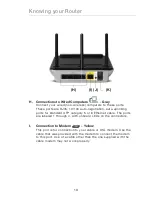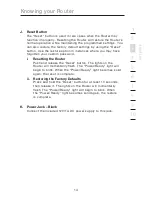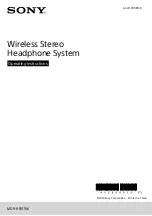
2
Introduction
2
2
1
3
4
5
6
7
8
9
10
s
e
c
tio
n
Revolutionary N1 Wireless Technology with MIMO (N1 MIMO)
Your Belkin N1 Wireless Router uses a new smart-antenna technology
called Multiple Input Multiple Output (MIMO). N1 MIMO complies
with the IEEE draft 802.11n specification. It increases speed, range,
reliability, and spectral efficiency for wireless networking systems.
The element that makes Belkin’s N1 MIMO technology different
from a conventional radio is the use of multiple antennas and two
simultaneous data streams to deliver wireless transfers around your
home or office. A conventional radio uses one antenna to transmit
a data stream. Belkin’s N1 MIMO, on the other hand, uses three
antennas. This design helps combat distortion and interference.
Belkin’s N1 MIMO is multidimensional. It builds on one-dimensional
smart-antenna technology by simultaneously transmitting two data
streams through the same channel, which increases wireless capacity.
Another element that enhances Belkin’s N1 MIMO is the use of
aggregation as specified in the draft 802.11n specification. By
shortening the space between packets and combining multiple smaller
packets into one larger packet, Belkin’s N1 MIMO can transmit more
data through available bandwidth.
Think of conventional radio transmission as a two-lane highway. The
speed limit governs the maximum allowable flow of traffic through
that lane. Compared with conventional radios, one-dimensional smart
antenna systems help move traffic through that lane faster and more
reliably—analogous to a four-lane road on which traffic consistently
moves at a rate closer to the speed limit. Belkin’s N1 MIMO helps
traffic move at the speed limit and opens more lanes—to become the
superhighway in this example. The rate of traffic flow is multiplied by
the number of lanes that are opened.
Summary of Contents for F5D8231-4ei
Page 2: ...User Manual F5D8231 4ei N1 Wireless Router ...
Page 3: ......







































